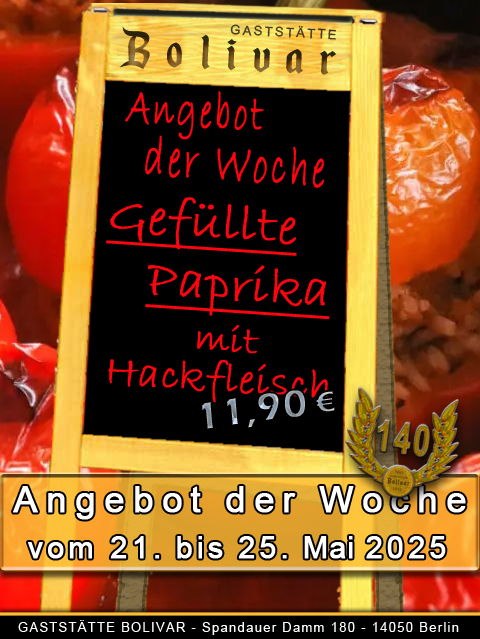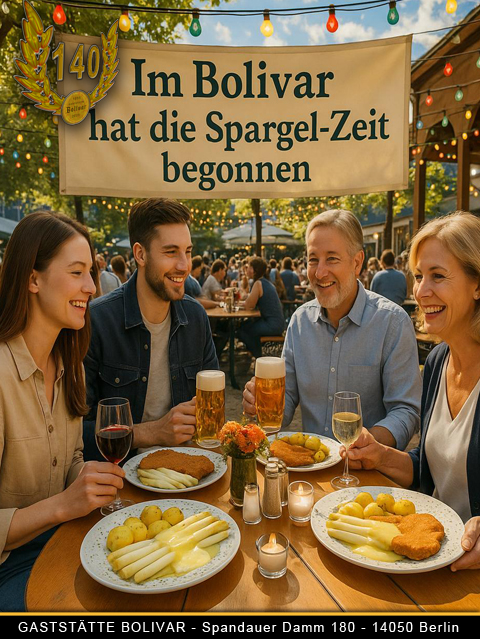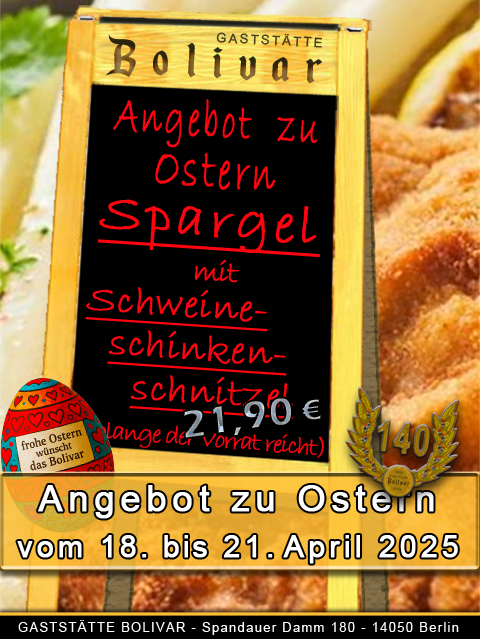An unconventional establishment restaurant local pub garden pub snack bar small biker meeting point offering German and partly international cuisine along with a lovely beer garden in Berlin-Charlottenburg
The Gaststätte Bolivar in Berlin-Charlottenburg-Wilmersdorf offers a unique combination of restaurant, pub, garden pub, snack bar, small biker meeting point, beautiful beer garden, and event location. Our guests describe us as different from what is usually expected - and we are very pleased with that, as it is meant positively. With our diverse offerings, we try to enliven the Westend neighborhood: seasonal dishes on the menu, exciting game evenings (Bingo, Chicago, Skat), and varied events (flea markets, Easter party, Oldie Night, Schlager night, Oktoberfest, Christmas offers). Although we do not belong to the traditional old Berlin inns, our offerings have been very well received so far - a sign that we are on the right track. At our place, guests do not have to pay for tickets or admission in advance. Our beautiful terrace is particularly inviting and perfect for lingering. In addition to our website, we have also set up a WhatsApp group for our guests and offer free Wi-Fi.
But it's not just the events that define us, but above all our gastronomy. We want to offer you delicious food, refreshing drinks, and more all year round. We adapt our menu to the seasons. It is important to us that price and performance are in the right balance - so you can visit us even in economically difficult times. Pay attention to our special offers. And if you prefer to eat at home, no problem - you can also order our dishes to take away. Please note, however, that some offers must be ordered in advance to ensure freshness.
At Bolivar, you can also host your private party, whether it's a company party, birthday, wedding, christening, or Christmas party, with our support. Contact us in advance so we can plan together - whether for 2024, 2025, 2026, or beyond! The concerns and satisfaction of our guests are always very important to us. We implement your wishes with passion and love.
The history of Westend Berlin (Source: DeWiki.de)
For a long time, the sandy, wooded highland was sparsely built with a few windmills. After the victory in the Battle of Jena and Auerstedt in 1806, Napoleon set up a camp for his occupation troops on the undeveloped eastern slope of Westend, roughly along today's Königin-Elisabeth-Straße. He himself resided in Charlottenburg Palace. The camp, named Napoleonsburg, was built on Napoleon's orders by the French governor of Berlin, Victor Duke of Belluno, in June and July 1808 and was already dismantled on November 2, 1808. The front of the roughly rectangular camp ran from Wundtstraße at Lietzensee in the south to today's DRK Clinics Westend near Fürstenbrunn, with a width of about one kilometer. It consisted of 380 residential barracks for 20 men each, as well as 64 larger barracks for kitchens and dining rooms, and two rows of better-equipped barracks as accommodation for non-commissioned officers.
After the withdrawal of the French troops, Westend fell back into a deep sleep. The forest, which had largely disappeared due to the camp and deforestation in the area, apparently never recovered. Around 1900, the painter Heinrich Zille lived on Sophie-Charlotten-Straße opposite Westend and documented the sandy wasteland on the slope in numerous photographs, where Napoleon's camp had been almost a hundred years earlier.
In 1840, a Bavarian brewer who brewed Bock beer in Spandau acquired the land at the corner of Spandauer Damm and Reichsstraße and opened a small tavern there, which was popularly called "Spandauer Bock". In 1854, he moved his brewery to the opposite site of Spandauer Berg, which was henceforth called Spandauer Berg Brewery. The inn that emerged there was popularly called "Zibbe" (North German for "ewe"). Over time, a lively excursion traffic developed from Charlottenburg and Berlin to the "Spandauer Bock". The two excursion restaurants and the brewery were destroyed in World War II and were not rebuilt.
The development of Westend in its present form began in the late 1860s. The wealthy magazine publisher Ludwig von Schaeffer-Voit had Ruhwald Castle built east of the brewery on the slope towards the Spree and laid out a generous landscape garden around the castle, today's Ruhwald Park.
Around the same time, the limited partnership on shares "Westend," founded in 1866 by Albert Werckmeister (together with Heinrich Quistorp, the architect Martin Gropius, the banker Eichhorn, and the lottery collector Tuchen), began to buy up large areas in Westend, subdivide them, and resell them developed or undeveloped. Shortly after its founding, however, the company ran into difficulties. After its dissolution in 1868, the business was taken over by the Westend-Gesellschaft H. Quistorp & Co. in Berlin, in which Heinrich Quistorp - brother of Johannes Quistorp, who was simultaneously building the Stettiner Westend - and Ferdinand Scheibler were personally liable partners. To supply Westend with water, the waterworks at Teufelssee were built from 1871 to 1872. Due to the stock market crisis of 1872 and disputes with the city of Charlottenburg, the Westend-Gesellschaft ran into financial difficulties and went bankrupt in 1873.
With the completion of the Ringbahn, the Westend station was opened in 1877, which significantly improved the traffic situation not only for Westend but also for Charlottenburg. The Charlottenburg station on the Stadtbahn followed only in 1882.
After the collapse of the Westend-Gesellschaft, construction activity in Westend initially came to a halt, and some villas stood empty. However, from the late 1870s, the situation relaxed. Due to the population increase in the Berlin area, Westend experienced a boom, so that by the turn of the century, the originally parceled land was essentially built up. On the slope of the Teltow, between Soor- and Königin-Elisabeth-Straße, the barracks of the Queen Elisabeth Guard Grenadier Regiment No. 3 were built in the 1890s, the Epiphany Church was built to the east in 1906 according to designs by Jürgen Kröger, and the Westend Hospital (today: DRK Clinics Westend) was built to the north in 1904.
In 1908, Westend was connected to the Berlin U-Bahn with the opening of the Reichskanzlerplatz U-Bahn station (today: Theodor-Heuss-Platz) designed by Alfred Grenander. This also made the southern and western areas of Westend easily accessible, leading to the creation of Neu-Westend along Reichsstraße and to the west. While the old Westend was laid out in a rectangular grid, curved lines in the zeitgeist style were chosen outside the main axes. Instead of villas like in the old Westend, rental and terraced houses dominate in Neu-Westend. The trotting track, opened in 1889 on Neu-Westend land, was moved to Ruhleben in 1908. On the site of a gravel pit, the Sachsenplatz (today: Brixplatz), a small, deeply cut park that replicates the geology and vegetation of the Mark Brandenburg, was created by Charlottenburg's city garden director Erwin Barth from 1919 to 1922.
To mark the opening of the German Stadium in 1913, the U-Bahn line was extended for events to the Stadion U-Bahn station (today: Olympia-Stadion). The Neu-Westend station, which was already structurally completed in 1913, was only put into operation in 1922 due to the war events, allowing the U-Bahn line to be regularly operated. From 1907 to 1911, the Spandau suburban railway was built, which today serves the district with the S-Bahn stations Messe Süd (Eichkamp), Heerstraße, Olympiastadion, and Pichelsberg.
In the 1920s, the extensive facilities of the German Sports Forum were built on the northwestern edge of Westend. Also during this time, the Berlin Exhibition Grounds were established in the southeastern part of the district. At the end of the 1920s, architects of the Bauhaus and New Objectivity movements, such as Mendelsohn and the brothers Hans and Wassili Luckhardt, built their own villas, now listed buildings, on Am Rupenhorn, the high bank above the Stößensee. On the occasion of the 1936 Summer Olympics, the Berlin Olympic Grounds and the Deutschlandhalle were built.
The traditional district of Westend in Berlin-Charlottenburg-Wilmersdorf
The Bolivar restaurant is located in Westend, a traditional district in the Berlin borough of Charlottenburg-Wilmersdorf. Westend has a fascinating history: Originally planned as an exclusive villa colony and named after the prestigious London district of West End, this district has partially lost its originally planned character over time.
In the 1950s and 60s, during the division of Berlin, typical Berlin apartment buildings were built in some areas of Westend, causing the former residential culture of the villa colony to be lost. This change is particularly noticeable on Reichsstraße, the main shopping street of the district. Instead of the originally planned villas and mansions, shops, cafes, and restaurants now dominate the streetscape.
Nevertheless, Westend has many charming, differently designed squares to offer: Theodor-Heuss-Platz, Branitzer Platz, Anneliese-und-Georg-Groscurth-Platz, Brixplatz with Brixpark (formerly Sachsenplatz), Steubenplatz, Fürstenplatz, and Karolingerplatz are just a few examples of the varied design of the district.
Strategically located between Charlottenburg Palace, Berlin-Westend S-Bahn station, Kaiserdamm, Lietzensee, and other well-known places, Westend offers numerous sights: the radio tower, the International Congress Center Berlin, the Olympic Stadium, the listed Corbusierhaus, historic water towers, and many other interesting buildings from different eras.
Furthermore, Westend has been and still is home to many prominent personalities: Marlene Dietrich, Willy Fritsch, Gustav Fröhlich, Dieter Hallervorden, Johannes Heesters, Hildegard Knef, Joachim Ringelnatz, Heinz Rühmann, Max Schmeling, Bubi Scholz, and Richard Strauss are just a few of the well-known names associated with this district.
A special highlight is the Teufelsberg, a 120-meter-high rubble hill in the west of Berlin, offering a breathtaking view over the Westend district and the entire city. A walk through the nearby Olympiapark is also worthwhile.
Overall, Westend combines a fascinating mix of tradition and modernity, villa idyll and urban vibrancy - a district with a lot of charm and history that invites visitors to discover and linger.
Discover Berlin - what's happening in the city today? Come by and be inspired by our unique surroundings and our restaurant "Bolivar". We would be delighted to welcome you.
You can find us at Spandauer Damm 180, between Charlottenburg Palace, Luisenplatz, Otto-Suhr-Allee, and Kaiser-Friedrich-Straße, up to the corner of Rominter Allee / Charlottenburger Chaussee at Ruhleben U-Bahn station (towards Spandau). Our location is central but still quiet - we are located at the Gartenkolonie Golfplatz, slightly set back but clearly visible from Spandauer Damm (see map).
Whether you come alone, as a couple, with family, friends, or colleagues - we welcome you at any time. All year round, in any weather - in spring, summer, autumn, and winter - we look forward to welcoming you.
Let yourself be tempted by our diverse offerings: Enjoy our lunch, a delicious dinner, or try something from our snack bar in between, sometimes directly from the grill. Also, take a look at our event program - maybe you'll find something suitable for you.
We look forward to welcoming you at "Bolivar" and providing you with an unforgettable stay. Come by and discover our place!
Here you can find us:
We are located between the A100 motorway (near AVUS), DRK Hospital Westend, Theodor-Heuss-Platz (Messe Berlin), Reichsstraße (near Olympic Stadium), Brixplatz, Ruhleben, Spandau, Siemensstadt, and Ruhwald Park, directly at Spandauer Damm 180, in 14050 Berlin - Charlottenburg-Wilmersdorf, in the Westend neighborhood.
By BVG: BUS M45, Kirschenallee stop - the Neu-Westend U-Bahn station (U2 / U-Bahn line 2) is within walking distance.
News 8.08.2024














